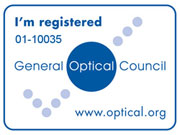Contact Lens Fitting at Euin Steele & Partners
Soft Lens Fitting
Rigid Gas Permeable Fitting
Hybrid RGP/Soft lens Fitting
Orthokeratology Contact Lens Fitting
Keratoconus Contact Lens Fitting
Pellucid Marginal Degeneration (PMD)
Corneal scarring
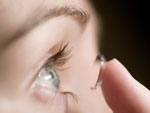 As Contact Lens Specialists we can offer fitting of all the forms of contact lenses available from around the world. These include Soft disposable, rigid gas-permeable , semiscleral, hybrid and specialised cosmetic lenses.
As Contact Lens Specialists we can offer fitting of all the forms of contact lenses available from around the world. These include Soft disposable, rigid gas-permeable , semiscleral, hybrid and specialised cosmetic lenses.
At a Contact Lens Assessment you can be assured that we will discuss with you all the different types of lenses available and advise you the most suitable.
All of these regimens can be organised in a monthly payment plan inclusive of professional time for aftercare as well as part of our Eyeplan Scheme which offers the lenses at Eyeplan Prices.
Soft Contact Lenses
Soft contact lenses are the most common fitted lenses around the world. They offer good vision,
flexibility of wear (from a few hours a year to all day every day), good comfort and ease of
adaptability. They do have a slightly higher risk of eye infection than some other lenses and can be
a little higher in cost. Wear regimens vary from daily disposable, two weekly or monthly
disposable through to overnight wear lenses. We fit all the major manufacturers lenses including
Johnson & Johnson (Acuvue), Alcon-Ciba, Coopervision, Ultravision and Bausch & Lomb as well
as smaller specialised manufacturers such as Mark E’nnvoy and David Thomas.
These lenses are available as single vision or multifocal.
Rigid Gas-Permeable Lenses
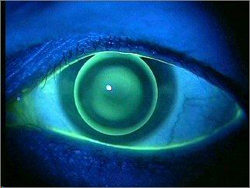 Rigid GP lenses are specialist lenses which usually offer a superior vision to that possible with soft
Rigid GP lenses are specialist lenses which usually offer a superior vision to that possible with soft
lenses. They have a much lower risk of eye infection to that of other types and are usually the least
expensive to wear. They need a short adaptation time, approximately two to three weeks before
complete comfort is attained but once adapted too they can allow very long wearing times with very
good comfort. This type of lens is can be safely fitted to people of all ages including children and is
often used in specialist lens fitting such as is needed in patients with Keratoconus.
These lenses need a little more ‘chair time’ to fit as they are manufactured individually bespoke but
the lenses can last up to a year or even longer. There are also larger, semiscleral RGP lenses now
available which offer less adaptation time than the smaller traditional lens types.
These lenses are available as single vision or multifocal correction.
Hybrid Lenses
They are manufactured with a rigid gas-permeable centre section and a soft lens ‘skirt’ which offers
the superior vision of rigid gas-permeable lenses with the ease of adaptation of soft lenses. The
lenses are replaced six-monthly and are especially suitable for people with astigmatism. They can
be worn by people of all ages and patients with corneal conditions such as keratoconus.
These lenses are only available as single vision lenses.
Orthokeratology
(corrective treatment for short-sightedness)
Orthokeratology is a process that uses specially designed rigid gas-permeable contact lenses to
temporarily reshape the contour of the cornea to reduce myopia (nearsightedness). The contact
lenses are worn overnight to allow you to have fully corrected vision throughout the day without
wearing contact lenses or spectacles.
Orthokeratology is nicknamed "ortho-k" and sometimes called corneal reshaping (CR), corneal
refractive therapy or vision shaping. Research has also demonstrated that orthokeratology lens
designs slow the progression of myopia.
Good candidates for orthokeratology include youngsters age 8 to 12 with progressive
shortsightedness (myopia), as well as most adolescents and adults, although the best success is with
people under age 40. Ortho-k is recommended for low to mild nearsightedness (-4 diopters or less).
People who are not good candidates include those with dry eye syndrome, a large pupil size, or high
myopia.
The Orthokeratology Process
Following assessment if the optometrist feels you are a good candidate for orthokeratology, you will
wear specially designed GP lenses at night only. In the one to two week treatment phase, your
nearsightedness is gradually reduced or fully corrected. Since vision will be changing, some
patients may need to wear disposable soft lenses during the day in the early part of the treatment
phase until full correction through the day is achieved.
Once the treatment is over, you wear the GP lenses at night only and see well during the day
without any corrective lenses. Some people need to wear their lenses only every other night, or
even once or twice a week, to maintain the effect.
You will need to see your eye care professional regularly to ensure your lenses are fitting well and
your eyes are healthy. Since during sleep the lenses fit tightly on the eye, it's especially important to
clean and disinfect the lenses upon removal each morning.
Ortho-k: Great for Sports
Young people whose nearsightedness is progressively increasing are often excellent candidates for
orthokeratology. Studies have found that these specially designed ortho-k lenses can reduce existing
myopia when worn overnight. As young people are very active athletically, this often allows them
visual freedom to play sports without wearing spectacles or contact lenses.
Orthokeratology and Myopia Control
In addition to the benefit of lens-free daytime vision, orthokeratology is starting to be appreciated
for its ability to slow the progression of myopia. A number of published clinical studies have found
that orthokeratology lens designs inhibit the growth of the eye's axial length, which determines the
degree of myopia.
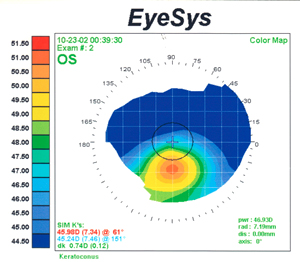
The Practice offers a specialised therapeutic contact lens service offering contact lens fitting for a range of eye conditions where spectacles do not give the required performance. We fit these lenses through the Orsett and Southend Hospital Trusts or as a private contact lens patient.Keratoconus is a vision disorder that occurs when the normally round cornea (the front part of the eye) becomes thin and irregular (cone) shaped. This abnormal shape prevents the light entering the eye from being focused correctly on the retina and causes distortion of vision.
In its earliest stages, keratoconus causes slight blurring and distortion of vision and increased sensitivity to glare and light. These symptoms usually appear in the late teens or late 20s. Keratoconus may progress for 10-20 years and then slow in its progression. Each eye may be affected differently. As keratoconus progresses, the cornea bulges more and vision may become more distorted.
Spectacles or soft contact lenses may be used to correct the mild shortsightedness and astigmatism that is caused by the early stages for keratoconus. As the disorder progresses and cornea continues to thin and change shape, specialised rigid gas permeable, soft or hybrid contact lenses can be prescribed to correct vision adequately. In most cases, this is adequate. The contact lenses must be carefully fitted, and frequent checkups and lens changes may be needed to achieve and maintain good vision. Detailed corneal shape images are taken to aid the fitting and follow up visits. This also allows careful monitoring of the condition.
In a few cases, a corneal transplant is necessary. However, even after a corneal transplant, eyeglasses or contact lenses are often still needed to correct vision.
Pellucid Marginal Degeneration (PMD)
Pellucid Marginal Degeneration is a degenerative corneal condition, often confused with keratoconus. It is typically characterized by a clear, bilateral thinning (ectasia) in the inferior and peripheral region of the cornea, although some cases affect only one eye. The cause of the disease remains unclear (idiopathic).In this condition, spectacles do not give satisfactory vision and specialised rigid gas permeable, soft or hybrid contact lenses can be used to give improved optical quality to the image.
Corneal scarring
Corneal scarring can be caused by ocular trauma or infection. It can be disfiguring and confidence can be lost when in social surroundings. The Practice offers specialised cosmetic contact lenses which cover the scarred area and give a much more natural appearance. These lenses can be powered or made to occlude vision and can be worn occasionally or full time. The lenses are hand-painted by artists and often need more visits than standard lenses.
Tel: 01375 373000
Services



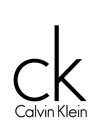

Copyright © EUIN STEELE
Design by Computer Confidence


